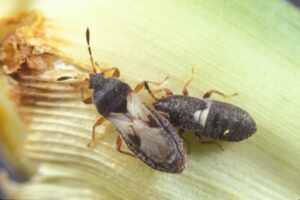Active Seasons
Chinch Bugs Appearance and Size Facts
Chinch bugs are notorious pests that wreak havoc on lawns, especially in hot, dry, sunny conditions. These tiny insects have black bodies adorned with distinctive white triangular patterns on their wings, creating an hourglass or crossed-arms pattern. Juvenile chinch bugs progress from red to brown before maturing into winged adults with the characteristic black-and-white coloration. They typically measure between 1/8 to 1/6 inch long, preferring lawns as their primary habitat.
Chinch bugs are known for causing extensive damage quickly, mainly to St. Augustine turf grass, making them a significant concern for homeowners with lush lawns.
Distinguishing Chinch Bugs From Other Lawn Pests
Distinguishing chinch bugs from other lawn pests can be challenging due to their small size and similar body shapes. The key identifying features include their black bodies with white triangular patterns on the wings. While these features may be distinct, they can easily remain undetected in your home or lawn without the expert eye of an exterminator from Hulett.

Behavior and Habitat of Chinch Bugs
Female chinch bugs deposit over 250 eggs in their lifetime, typically on leaf blades in turf, close to where the plant contacts the soil. During summer, these eggs hatch in six to 13 days, with a more prolonged process lasting over a month during winter. Chinch bugs thrive in hot, dry, sunny areas of lawns, causing rapid and extensive damage. They extract sap from grass blades, leading to the plant’s withering, yellowing, and eventual death, so early identification should be a top priority.

Signs of Infestation of Chinch Bugs
Detecting chinch bugs involves a simple test. Placing a bottomless can near the edge of a dead patch of lawn and filling it with water allows you to observe floating chinch bugs within a few minutes. Chinch bug activity often begins near surfaces such as driveways, sidewalks, and curbs, so perform the test in these areas for the best results.

Tips for Prevention of Chinch Bugs
Give your lawn plenty of shade and water and avoid over-fertilizing to make the environment less enticing for chinch bugs without harming your grass. Inspect your turf for damage often. Once you have identified a chinch bug infestation near your home, it is time to call the professionals.
Getting Rid of Chinch Bugs
Chinch bugs can reproduce rapidly, and they can damage turf quickly, as well. Because of resistance to over-the-counter products, professional pest control services are the only option to provide reliable results if you identify a chinch bug infestation.
Effective Chinch Bug Control Solutions
For comprehensive chinch bug control solutions, just call Hulett. With over 50 years and three generations of family-owned pest control services, we know how to identify infestations before they happen so we can implement our specialized chemical solutions to stop them in their tracks.
Schedule your free inspection online or contact us today to ensure your lawn remains healthy and free from chinch bug infestations.
Chinch Bugs Gallery

